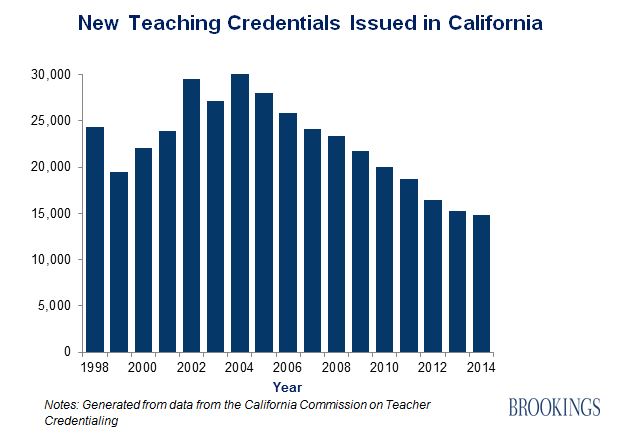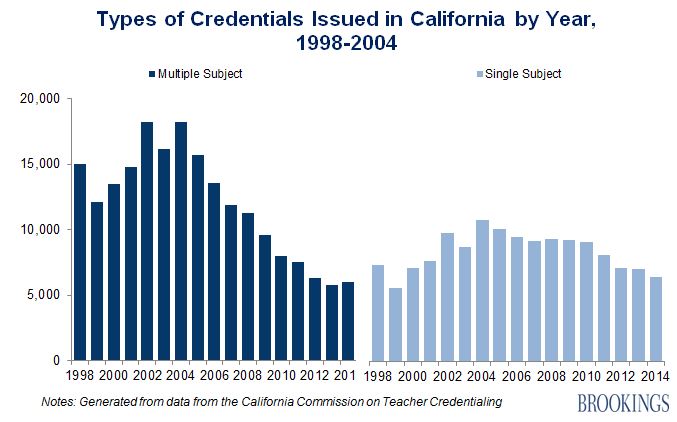Many contemporary education reform efforts attempt to leverage teacher evaluation policy to improve teacher quality, by making the evaluation process more rigorous or by tying results more directly to student learning outcomes, for example. By increasing the demand for high-quality teaching and teachers, these reforms have had some success. However, insufficient attention to the supply of teachers may be preventing many teacher quality and evaluation reforms from realizing their full potential.
To be clear, there is preliminary evidence suggesting that contemporary evaluation reforms may in at least some cases have the desired effects. For example, raising the rigor and stakes of teacher evaluations in New York City and Washington, DC seems to have improved teacher quality in both locations, whether through teacher improvement or selective attrition of weaker teachers.
At the same time, however, many other contentious efforts to reform teacher evaluation have resulted in little change to teacher evaluation outcomes. Recent statewide efforts to make evaluations more rigorous and meaningful in New Jersey, New Mexico, New York, Florida, Indiana, Rhode Island, Maryland, and Hawaii, for example, have resulted in the vast majority of teachers— often well over 90%— continuing to receive ratings of “effective” or “highly effective.” These reforms may have been valuable, but they have disappointed reformers who are skeptical that the results accurately reflect the quality of the teaching force in schools where large numbers of students are not academically proficient.
If we are surprised by the often muted effects of teacher evaluation reform, that is perhaps because we are insufficiently sensitive to the forces that contribute to seemingly inflated teacher evaluations. And there are many reasons why managers might—and often do— tend to evaluate their employees highly, including: aversion to interpersonal conflict; genuine beliefs about the quality of the employees they’ve hired; and the maintenance of workplace morale.
Additionally, many teacher evaluation reform efforts may be focused too heavily on the demand side of teacher evaluation. That is, many reform efforts tend to assume that principals are overly generous with their evaluations because they lack either the motivation or the information to demand better performance from their teachers. There may be something to this, but it is important not to ignore the supply side of the teacher quality problem. After all, the extent to which a principal is willing to dismiss (or give a poor evaluation to) a teacher will likely depend in part upon her beliefs about the probability of finding a superior replacement in a reasonable period of time.
The extent to which principals today are constrained in their evaluation and dismissal decisions by the quality and size of the teacher labor supply is not obvious and probably varies by grade level, content area, and geographic location. There are, however, reasons to suspect that teacher supply constraints are real and may be getting worse.
As an example, consider my own state of California. A number of states have seen steep drops in enrollment in teacher preparation programs in recent years, and the declines are particularly stark in California. The number of new teaching credentials issued in the Golden State has fallen for ten consecutive years, for a total drop of 53 percent from the peak in 2004. (Total K-12 public school enrollment in California is up nine percent since 1998 and has declined one percent since 2004.)

The vast majority of this decline is attributable to a sharp drop in the number of multiple subject credentials (usually granted to elementary school teachers), which may suggest that elementary teachers have historically been overproduced in California. However, single subject credentials— generally required for middle and high school teachers— have fallen 41 percent since 2004 as well.

There is anecdotal evidence that these declines in new certifications are putting pressure on districts and administrators, with many schools reporting difficulty finding qualified applicants for some open teaching positions. California has also seen an increase in temporary teaching permits and waivers of normal credentialing requirements, possibly an indication of teacher supply constraints.
Ultimately, the extent to which the decline in new credentials is impacting districts’ hiring, principals’ evaluation processes, or students’ learning in California is not clear. It is nevertheless plausible that a shrinking supply of teachers increases principals’ uncertainty about their prospects for finding superior replacements for unsatisfactory members of their staffs, especially for certain harder-to-staff teaching positions. As a result, principals may be less inclined to dismiss their weak teachers or even to risk offending them with low evaluation scores.
Because the causes of our shrinking teacher supply are not entirely clear, it is difficult to know how best to respond. Still, some general—if mostly untested— principles suggest themselves.
First, stricter evaluation requirements should probably be coupled with more aggressive teacher recruitment and retention policies. Higher salaries or more pleasant working conditions could go a long way toward growing the supply of teachers and toward making sure that good teachers aren’t leaving voluntarily. There is evidence that teacher turnover is harmful to student achievement, and a principal faced with replacing several voluntarily-departing teachers may be less inclined to evaluate the teachers who remain more harshly.
Second, policymakers should consider systems of differential compensation and evaluation that allow districts and administrators to be more generous or flexible with harder-to-staff teaching positions. This may mean higher salaries for teachers in certain schools, subject areas, or grade levels. It could also mean somewhat looser evaluation requirements for teachers who, realistically, would be more difficult to replace. Allowing administrators to waive subsequent observations and evaluations for math teachers who perform well early in the year, for example, could both gratify math teachers and free principals to focus their evaluation efforts where they may be more useful.
The fact that the supply of teachers can change dramatically suggests that we should perhaps focus more on the supply side of teacher quality issues. Researchers should examine more carefully the extent to which teacher supply can be manipulated and the ways in which it impacts (or doesn’t impact) student learning and human resources for schools. Reformers and policymakers, meanwhile, should be mindful of whether their preferred reforms depend on—or have implications for— the quantity and quality of the teacher supply.



Commentary
The importance of the teacher supply to education reform
July 20, 2015